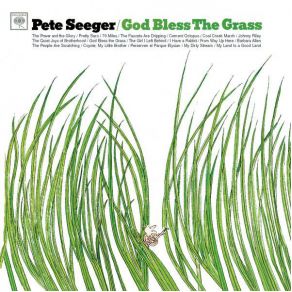God Bless the Grass
Download links and information about God Bless the Grass by Pete Seeger. This album was released in 1966 and it belongs to World Music, Songwriter/Lyricist, Contemporary Folk genres. It contains 21 tracks with total duration of 45:49 minutes.

|
|
|---|---|
| Artist: | Pete Seeger |
| Release date: | 1966 |
| Genre: | World Music, Songwriter/Lyricist, Contemporary Folk |
| Tracks: | 21 |
| Duration: | 45:49 |
| Buy it NOW at: | |
| Buy on iTunes $9.99 | |
| Buy on iTunes $11.99 | |
| Buy on Amazon $8.99 | |
| Buy on Amazon $9.99 | |
Tracks
[Edit]| No. | Title | Length |
|---|---|---|
| 1. | The Power and the Glory | 2:29 |
| 2. | Pretty Saro | 3:02 |
| 3. | 70 Miles | 2:22 |
| 4. | The Faucets Are Dripping | 2:00 |
| 5. | Cement Octopus | 2:21 |
| 6. | God Bless the Grass | 2:01 |
| 7. | The Quiet Joys of Brotherhood | 4:01 |
| 8. | Coal Creek March | 1:15 |
| 9. | The Girl I Left Behind | 1:16 |
| 10. | I Have a Rabbit | 1:57 |
| 11. | The People Are Scratching | 3:37 |
| 12. | Coyote, My Little Brother | 2:50 |
| 13. | Preserven el Parque Elysian | 3:14 |
| 14. | My Dirty Stream (The Hudson River Song) | 2:29 |
| 15. | Johnny Riley | 0:52 |
| 16. | Barbara Allen | 1:10 |
| 17. | From Way Up Here | 2:59 |
| 18. | My Land Is a Good Land | 2:19 |
| 19. | America, the Beautiful | 0:45 |
| 20. | Business | 0:50 |
| 21. | There'll Come a Time | 2:00 |
Details
[Edit]Since he signed a non-exclusive contract with the major-label Columbia Records in 1961, Pete Seeger has released six LPs through the company, all of them drawn from concert recordings. God Bless the Grass, his seventh Columbia LP, is his first to have been recorded in a studio. For anyone accustomed to listening to his studio albums for Folkways Records, the tiny independent label for which he continues to record occasionally, this disc will be a sonic revelation. True, it's an unadorned Pete Seeger record, which means that it consists of him alone, his reedy tenor voice, his acoustic guitar, his banjo, and, now and then, his whistling or his blowing into a recorder. But unlike the cheaply made, first-take performances of the Folkways LPs, this is clearly music that was made in a professional studio with good microphones before a producer (Tom Wilson) who apparently wasn't above making sure that everything was in tune or even asking for another take if Seeger went off-key or flubbed a lyric or played a clam. The result isn't exactly slick, but it creates a sound noticeably better than the run-of-the-mill Seeger LP. Immediately, as natural echo enhances the voice and instruments, God Bless the Grass sounds like what it is, a major-label album. While Seeger himself might not care (or even might prefer the more primitive Folkways approach), the recording style benefits the contents, since God Bless the Grass is a concept album. Seeger has left home the anti-war and pro-Civil Rights songs along with the children's songs, and except for a few interludes, he has focused on another political concern. The album is about conservation and pollution. From dripping faucets that drain the water supply ("The Faucets Are Dripping") to grass growing through the concrete ("God Bless the Grass"), Seeger moves on to the dangers of pesticides and other poisons ("The People Are Scratching," "Coyote My Little Brother"), then gazes into his own backyard, i.e., the Hudson River that runs by his home in Beacon, NY ("My Dirty Stream [The Hudson River Song]"). Typically, he tries to be instructive, pointing out how the food chain affects every living thing in it, and how, while each individual who pollutes, if only by flushing a toilet, may not see the problem, nevertheless, collectively it harms everyone. He also tries to be optimistic, hoping that someday the process can be reversed, even if he acknowledges that it may take a while. [After Columbia allowed God Bless the Grass to go out of print, Folkways licensed it for reissue in 1982. In 1998, Columbia/Legacy released the album on CD with three previously unreleased bonus tracks recorded at the same sessions: a brief Seeger instrumental take on "America the Beautiful"; the first part of "Business," co-written by Seeger and Walter Lowenfels; and Malvina Reynolds' "There'll Come a Time." These added three minutes and 37 seconds to the album. This version, too, went out of print, but Smithsonian Folkways continued to keep the original version in print and available through mail order.]